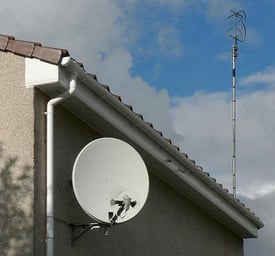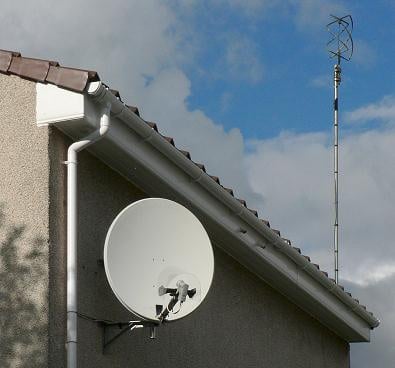As many people who live in communities operated by a community association know, one of the advantages, or disadvantages depending on who you ask, is that the association typically has the authority to regulate the improvements that are made by residents within the community. This authority will keep the purple house out of your neighborhood – good for those who would prefer to look out their window and not see a purple house, but bad for the person wanting the purple house. While most of the aesthetic qualities of a community can be regulated by the association through established architectural standards and guidelines that are set out in the community’s governing documents, the association is at times hamstrung by statutes or other regulations which govern certain improvements, such as solar panels, other energy saving devices and antennas.
 Of topic in this article are satellite dish antennas which receive video programming signals from direct broadcast satellites, broadband radio service providers, and television broadcast stations. As directed by the United States Congress in Section 207 of the Telecommunications Act of 1996, the Federal Communications Commission adopted the Over-the-Air Reception Devices (“OTARD”) rule concerning governmental and nongovernmental restrictions on the viewers’ ability to receive these video programming signals to antennas, including direct-to-home satellite dishes that are less than one (1) meter in diameter, television antennas, and wireless cable antennas.
Of topic in this article are satellite dish antennas which receive video programming signals from direct broadcast satellites, broadband radio service providers, and television broadcast stations. As directed by the United States Congress in Section 207 of the Telecommunications Act of 1996, the Federal Communications Commission adopted the Over-the-Air Reception Devices (“OTARD”) rule concerning governmental and nongovernmental restrictions on the viewers’ ability to receive these video programming signals to antennas, including direct-to-home satellite dishes that are less than one (1) meter in diameter, television antennas, and wireless cable antennas.
Under the OTARD rules, a resident has the right to install an antenna on property that the resident owns or over which the resident has exclusive use or control. In the case of a single-family home community, the right would extend over the lot as the lot is owned by the homeowner. In the case of condominiums and cooperatives, the OTARD rules apply to the unit and to the exclusive use areas, otherwise known as limited common elements, such as terraces, balconies, or patios.
As relevant to community associations, the OTARD rules prohibit restrictions that impair the installation, maintenance, or use of antennas used to receive video programming. Therefore, the OTARD rules prohibit most restrictions that (i) unreasonably delay or prevent installation, maintenance, or use; (ii) unreasonably increase the cost of installation, maintenance, or use; or (iii) preclude reception of an acceptable quality signal.
However, to the extent that an association’s regulations of satellite dish antennas may be accomplished without impairing reception of an acceptable quality signal, unreasonably preventing or delaying installation, maintenance, or use of a satellite dish, or unreasonably increasing the cost of installing, maintain, or using a satellite dish, the association would be able to create and enforce such regulations, especially where the need for the regulations are based upon express legitimate safety concerns and not merely for aesthetic reasons. For example, a regulation requiring that a satellite dish antenna be placed in a particular location on a house, such as the side or the rear of the house, might be permissible if this placement does not prevent reception of an acceptable quality signal or impose unreasonable expense or delay.
Additionally, as the OTARD rules are only applicable to property that a resident owns or over which the resident has exclusive use or control, these rules do not apply to common areas or common elements that are owned by a community association or jointly by condominium unit owners. Common areas and common elements typically include recreational facilities, the roof or exterior walls of a condominium or cooperative building, and right-of-ways. Therefore, an association may properly prohibit a resident from installing a satellite dish antenna on the association’s common areas or common elements which are not for the exclusive use of the resident. Even if a resident cannot receive an acceptable signal from the resident’s lot, unit, or area of exclusive use or control, the association is under no obligation to provide the resident with a location for the resident to install their antenna.
Further, the OTARD rules do not prohibit an association’s restrictions on satellite dish antennas which extend beyond the resident’s area of exclusive use or control when installed. For example, an association may impose restriction upon a satellite dish that extends beyond the balcony or patio of a unit to be over the common elements. Therefore, in order for the OTARD rules to protect the resident’s antenna, the antenna must be installed wholly within the exclusive use area.
Does your community association have restrictions regarding satellite dishes and other antennas? If so, you may want to have your association’s attorney review these restrictions to ensure that they meet the requirements of the OTARD rules.
Jeffrey Rembaum, Esq. of Kaye, Bender, Rembaum attorneys at law, legal practice consists of representation of condominium, homeowner, commercial and mobile home park associations, as well as exclusive country club communities and the developers who build them. He is a regular columnist for The Condo News, a biweekly publication and was inducted into the 2012, 2013 & 2014 Florida Super Lawyers. He can be reached at 561-241-4462.

